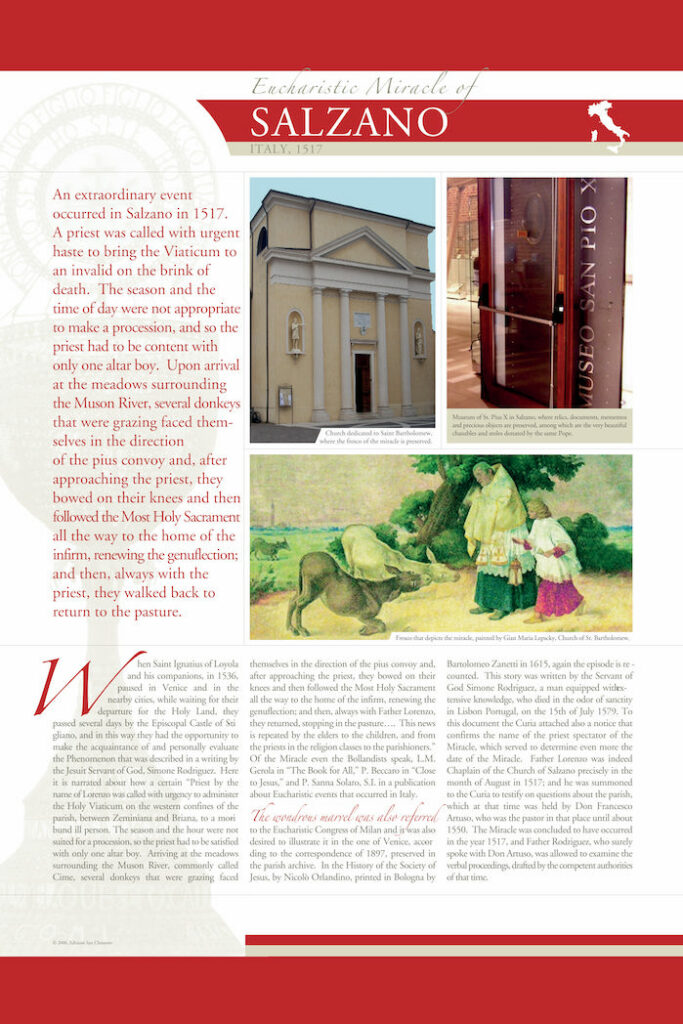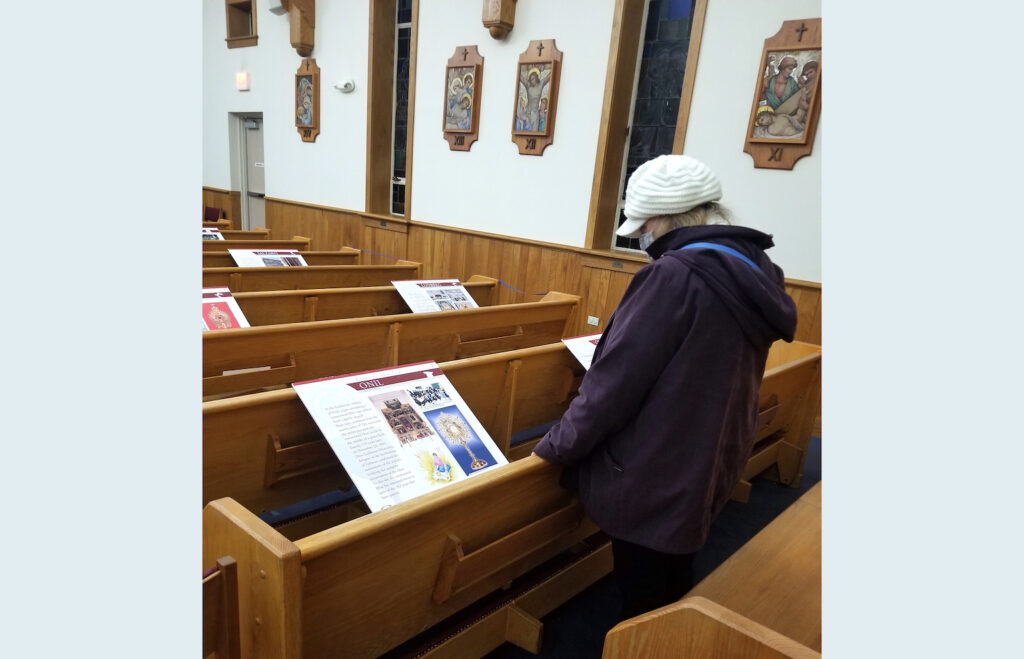Poster displays in Bedford, Moneta emphasize real presence
In a time of great hunger for Christ, the faith of Blessed Carlo Acutis, the Italian teenager who catalogued miracles of the Eucharist before his death in 2006, is alive in southwest Virginia. Two parishes recently created educational exhibits based on his life’s work, “The Eucharistic Miracles of the World.”
Father Sal Anonuevo, pastor of Holy Name of Mary, Bedford, and Resurrection, Moneta, learned about Blessed Carlo last fall and wanted to share the eucharistic miracles project with his parishioners. He heard of a church that filled its empty “social distancing” spaces in pews with displays describing the miracles and thought Holy Name of Mary could do the same.
“Also during this pandemic, it seemed like a good time to focus on the Eucharist,” Father Anonuevo said.
Since the December installation of posters depicting 10 selected miracles, he has seen many people studying them – adults, teens and children, as well as students from nearby universities.
“People can hardly believe all those miracles around the world, and some of them are recent,” Father Anonuevo said. “I was surprised myself. There were some that I didn’t know.”
Inspired by 15-year-old boy
Carlo Acutis (1991-2006), whom Pope Francis called “a 15-year-old boy in love with the Eucharist” and who was beatified in October 2020, was a devout Italian Catholic who used his computer skills to design a Vatican-approved website listing validated eucharistic miracles (“Miracoli Eucaristici”) around the world. The project, begun when he was 12, was completed one year before his death from leukemia.
Father Anonuevo approached Paul Roderique, evangelization chair at Holy Name of Mary, with his idea about an exhibit of eucharistic miracles using posters available on Blessed Carlo’s website. Roderique liked the idea, and so did the parish’s Brotherhood of Catholic Men, a group that gathers to pray and make rosaries.
“In one of our meetings, we had discussed what we could do to promote the real presence of Christ, because not enough Catholics understand or believe in it,” Roderique said. “So when this project presented itself, it was an answer to a prayer.”
Using about $500 from both the evangelization budget and from sales of the group’s popular “St. Dominic’s Daggers” – “tracking” rosaries with moveable beads to mark one’s place in prayer – the parish selected posters to download, which Roderique formatted, printed and mounted on foam core for display.

Each miracle is described in detail and illustrated with full-color images. Roderique said the miracles chosen covered a range of dates, i.e., from the Middle Ages to 2013, and areas, e.g., Europe, South America and Central America.
‘Remember who you are’
Many of the miracles describe bread and wine becoming flesh and blood before people’s eyes, and in some cases, the evidence is still on display, many years or even centuries later.
People tend to have their favorite miracles, Roderique noted. One that struck him is the 1906 miracle of Tumaco, Colombia, when a priest held up a host on the beach as a tsunami rose and suddenly subsided.
“The confidence of that priest to walk down to the shore in the face of that tsunami,” he said. “I thought, ‘Whoa, how come I didn’t know about all this?’”
Two miracles often shared by parishioners involve animals. One is the miracle of Salzano, Italy, in 1517, in which a priest carrying the Eucharist to an invalid came upon two donkeys. They bowed, walked with him to the house, bowed again and walked back with him until they reached their pasture.
The other is the 1348 miracle of Alboraya-Almacera, Spain. A priest crossing a river by mule fell into the water and dropped the chalice holding three hosts. Moments later, a fisherman found three fish, each holding a host in its mouth. When the priest held the chalice down to them, they placed their hosts inside and swam away.
“Everybody loves the animal stories,” said Tony Rivera, who belongs to the evangelical team and men’s group at Holy Name of Mary. “Animals have a different sense than we do.”
He also said the timing of this information – during what have been difficult and painful months for so many – is remarkable.
“We need to be reminded of the Blessed Sacrament and what it can do for us, right now, and not just what it has done in the past,” Rivera said. “Maybe this is part of a great reawakening in the Church, a way of telling us, ‘Remember who you are.’”
Teaching tool
Soon after the posters were installed, Tony and Sue Werner of Resurrection Parish attended Wednesday adoration at Holy Name of Mary. They were transfixed by the miracles.
“We read every one of them,” Tony Werner said, adding that even as a “cradle Catholic” he had not heard of many of them. “We thought this was something we needed to do at our parish, too. We knew it would be a wonderful teaching tool for everyone, especially for our youth.”
He contacted Roderique for help in getting a set of posters made for Resurrection. That church now has its own exhibit of different miracles, which, because it has chairs instead of pews, are displayed around the nave on easels.
Tony Werner said he believes knowledge of these miracles will help increase respect for the real presence of Christ in the Eucharist. It’s deepened his own faith as well. “I don’t normally do things like this, but I felt called to it,” he said, surprised at his involvement in the project. “The good Lord uses us to do his will.”
More focus on Eucharist
The project is growing. Sue Werner’s brother, who lives in the Werners’ hometown of St. Marys, Pennsylvania, asked Roderique to help create posters for his parish, Sacred Heart.
Karen McCloskey, the evangelical chairperson at Resurrection, hopes that word will continue to spread about this exhibit, which she calls a “treasure of the Church.”
“It makes you wonder how many little miracles do we have every day in our own lives?” she said.
McCloskey noted that the local Smith Mountain Lake community, which draws scores of visitors, can benefit from seeing the posters.
“I hope that lots of people, Catholics and non-Catholics, will come to see and learn about these miracles,” she said.
At Resurrection, she has noticed a change in behavior during Holy Communion.
“People seem more focused when receiving the Eucharist, more solemn,” McCloskey said. “When you’re surrounded by all these saints and miracles, it does have an effect.”
Resurrection’s director of youth ministry and education Melissa Murtagh plans to use the miracles with her catechism students to strengthen their relationship with Christ.
She recalled one third-grade girl who stood before a poster and turned to her older brother and said, “Wow, it’s real!”
“Her little face was all lit up,” Murtagh said. “This display is evangelizing by itself.”
She has felt it, too.
“It’s been part of my Lenten journey, when going up to receive holy Communion, and these miracles are right in front of your eyes,” she said.
Her daughter, Catherine, 11, agreed.
“I felt that all the miracles really prove that Jesus really is in the Blessed Sacrament,” she said. “And that God definitely wants us to believe because in some of them, the people in the stories had doubts, and he shows us that it is really his flesh and blood.”
So far, there are 27 miracles mounted on 44 panels between the two churches.
Many are from Europe: Austria (Fiecht, 1310), Belgium (Liege, 1374), Croatia (Ludbreg, 1411), France (Avignon, 1433; Bordeaux, 1822; Faverney, 1608; Lourdes, 1888; Pressac, 1643), Holland (Boxmeer, 1400), Italy (Bolsena, 1264; Cava dei Tirreni, 1656; Lanciano, 750; Rome, 595 and 1610; Salzano, 1517; Siena, 1730), Poland (Sokolka, 2008; Legnica, 2013), Portugal (Santarem, 1247) and Spain (Alboraya-Almacera, 1348; Daroca, 1239; Ivorra, 1010; Onil, 1824).
Others are from South and Central America: Argentina (Buenos Aires, 1992), Colombia (Tumaco, 1906), Mexico (Tixtla, 2006) and Venezuela (Betania, 1991).
The parishes swap their posters monthly so parishioners have new material to read. As there are more than 150 miracles listed on Blessed Carlo’s website, both parishes plan to add to their displays.
“I hope and pray this will help strengthen people’s belief in the real presence of Christ,” Father Anonuevo said. “The Lord is working miracles everywhere.”
For more information, visit http://www.miracolieucaristici.org or contact Holy Name of Mary, Bedford, at (540) 586-8988.

